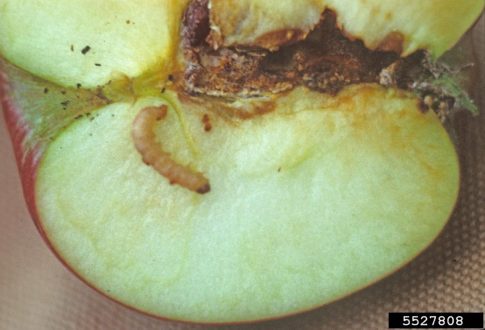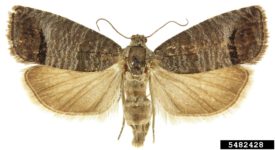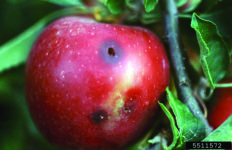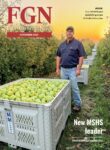
Jul 10, 2018Fruit pest control strategies help growers fight codling moth
For apple growers, codling moth is one of the most damaging pests. A single worm can make fruit unmarketable, whether for fresh sales or processing. Effective fruit pest control strategies — combining timely sprays, insecticide rotation, and IPM tools — are essential to preventing crop losses.

Timely sprays are critical
Codling moth control depends on hitting the right window with insecticides. Delta-shaped traps — tent-like devices with pheromone lures and sticky liners — help growers pinpoint moth flights. Once moths are detected, sprays must be applied before eggs hatch.
“You want to be tracking and monitor your moth flights,” said Diane Silcox Reynolds, Adama Agricultural Solutions development sector and insecticide leader. “The moth will lay those eggs either directly on the fruit or on the leaf very near to the fruit, and those eggs hatch and the caterpillars immediately start to crawl and burrow and feed on the apple. You have a very narrow window of when that happens. So, you want your product out before that happens.”
Rotating insecticides to avoid resistance
Codling moth can cycle through three to five generations in a season, requiring multiple sprays. Reynolds noted that growers may apply insecticides six to eight times during the season, making resistance management a priority.
“If you use the same product you’re going to select for the ones that are resistant to the product,” she said. “By hitting the bugs with a variety of chemicals, you’re reducing the overall number of resistant moths in a population, and decreasing the likelihood of the resistant bugs breeding together.”

Adama’s Cormoran, launched in 2016, combines two active ingredients: Novaluron, an insect growth regulator, and Acetamiprid, a neonicotinoid that targets the nervous system.
Buy Reynolds stressed the importance of rotation. She suggested alternating products across codling moth generations, such as using Cormoran early, FMC’s Altacor for the second brood, and Dow AgroSciences’ Delegate later in the season. Each product offers a different mode of action, which reduces resistance risk.
IPM options add protection

Non-chemical methods play a role in fruit pest control strategies, as well. Aerosol dispensers release codling moth pheromones throughout the orchard, disrupting mating.
“It fills the orchard with that pheromone and so the moths aren’t able to find each other,” Reynolds explained. “They call it mating disruption because they can’t find each other to mate.”
Washington State University’s Decision Aid Systems also recommends oil sprays to target moth eggs. Growers may add codling moth granulosis virus to oil sprays for additional protection.
Outlook for the season
The risk from codling moth remains high, especially in the Pacific Northwest. “Your damage threshold is so low, that growers will still make insecticide applications,” Reynolds said. “Anytime you have a caterpillar in your apple, even if it’s for juice, that could still decrease your quality and ultimately how much you get paid.”
She expects pest pressure to be similar to last year. “From what I’ve heard, they’re having an early spring again this year, so we would expect to be battling codling moth for much longer in the season,” Reynolds said.
Integrated fruit pest control strategies
By combining timely sprays, careful insecticide rotation, and integrated pest management tools, apple growers can stay ahead of codling moth. With pest pressure likely to persist, adopting diverse fruit pest control strategies will remain essential to protecting fruit quality and profitability.
– Stephen Kloosterman, FGN Assistant Editor
















